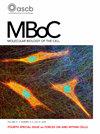GTP-微管蛋白帽并非细胞中微管末端稳定性的决定因素。
IF 3.1
3区 生物学
Q3 CELL BIOLOGY
引用次数: 0
摘要
微管是一种动态细胞骨架聚合物,对细胞分裂、运动和细胞内运输至关重要。微管动力学的特点是动态不稳定性--单个微管在生长和收缩阶段之间切换的能力。动态不稳定性可以用 GTP-帽模型来解释,该模型认为生长微管末端的 GTP-微管蛋白亚基 "帽 "具有稳定作用,可防止微管灾难--从生长到收缩的转换。虽然 GTP-帽被认为能保护生长中的微管末端,但 GTP-帽的大小是否会影响细胞中微管的稳定性尚不清楚。值得注意的是,微管末端结合蛋白家族--EBs--能识别微管蛋白的核苷酸状态,并在生长的微管末端显示彗星状定位,可作为 GTP-帽的替代物。在这里,我们采用高时空分辨率成像技术,将间期 LLC-PK1 细胞中 EB 彗星大小与微管动态之间的关系与体外测量结果进行了比较。我们的数据显示,细胞中的 GTP-cap大小与微管生长速度的比例与体外相同。然而,我们发现,即使在 EB 彗星消失后,细胞中的微管末端也能经受住向灾难的过渡。因此,我们的研究结果表明,GTP-帽的存在并不是细胞中微管末端稳定性的决定因素。本文章由计算机程序翻译,如有差异,请以英文原文为准。
The GTP-tubulin cap is not the determinant of microtubule end stability in cells.
Microtubules are dynamic cytoskeletal polymers essential for cell division, motility, and intracellular transport. Microtubule dynamics are characterized by dynamic instability-the ability of individual microtubules to switch between phases of growth and shrinkage. Dynamic instability can be explained by the GTP-cap model, suggesting that a 'cap' of GTP-tubulin subunits at the growing microtubule end has a stabilizing effect, protecting against microtubule catastrophe-the switch from growth to shrinkage. Although the GTP-cap is thought to protect the growing microtubule end, whether the GTP-cap size affects microtubule stability in cells is not known. Notably, a family of microtubule end-binding proteins, EBs, recognize the nucleotide state of tubulin and display comet-like localization at growing microtubule ends, which can be used as a proxy for the GTP-cap. Here, we employ high spatiotemporal resolution imaging to compare the relationship between EB comet size and microtubule dynamics in interphase LLC-PK1 cells to that measured in vitro. Our data reveal that the GTP-cap size in cells scales with the microtubule growth rate in the same way as in vitro. However, we find that microtubule ends in cells can withstand transition to catastrophe even after the EB comet is lost. Thus, our findings suggest that the presence of the GTP-cap is not the determinant of microtubule end stability in cells.
求助全文
通过发布文献求助,成功后即可免费获取论文全文。
去求助
来源期刊

Molecular Biology of the Cell
生物-细胞生物学
CiteScore
6.00
自引率
6.10%
发文量
402
审稿时长
2 months
期刊介绍:
MBoC publishes research articles that present conceptual advances of broad interest and significance within all areas of cell, molecular, and developmental biology. We welcome manuscripts that describe advances with applications across topics including but not limited to: cell growth and division; nuclear and cytoskeletal processes; membrane trafficking and autophagy; organelle biology; quantitative cell biology; physical cell biology and mechanobiology; cell signaling; stem cell biology and development; cancer biology; cellular immunology and microbial pathogenesis; cellular neurobiology; prokaryotic cell biology; and cell biology of disease.
 求助内容:
求助内容: 应助结果提醒方式:
应助结果提醒方式:


